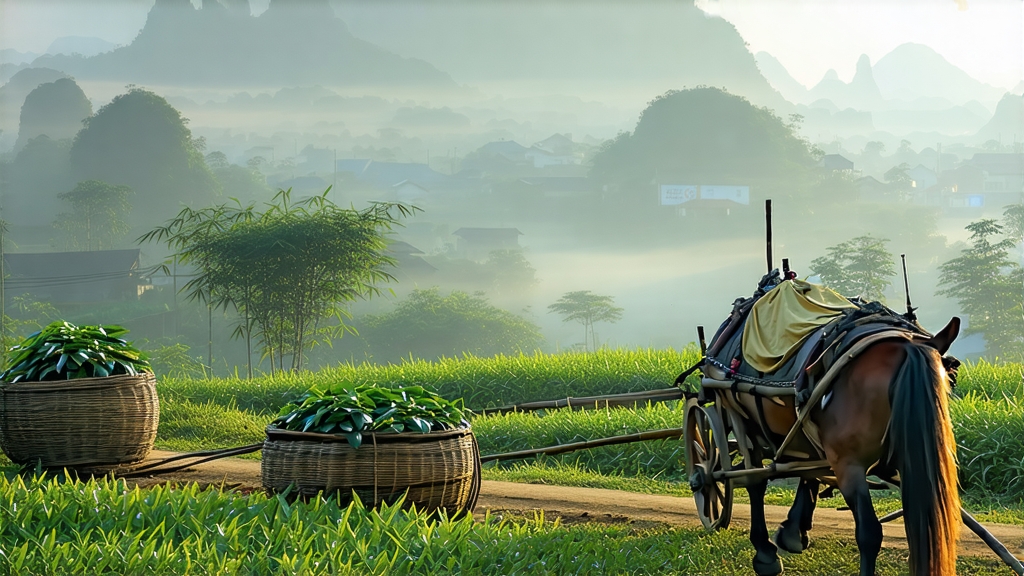
Liu Bao—pronounced “Lyo Bao”—is the quietest celebrity in China’s dark-tea family. While Pu-erh hoards the spotlight, Liu Bao has spent four centuries smoothing its edges in the humid mountain folds of Guangxi Province, emerging only when the world needs a darker, softer, more nostalgic cup. To understand Liu Bao is to listen to a tea that speaks in bass notes: camphor, damp bark, betel-nut sweetness, and the faint whistle of a horse bell disappearing into subtropical fog.
-
From Frontier Currency to Global Cup
The story begins in the small county of Cangwu, near the trading town of Wuzhou, where the Pearl River bends toward the South China Sea. During the Ming dynasty (1368-1644), imperial troops stationed in the malarial south were paid partly in compressed tea bricks; the leaf was lighter to carry than copper, never spoiled, and doubled as medicine for fever and dysentery. Local growers in Liu Bao village discovered that the hotter and more humid the storage, the faster the tea mellowed. By the Qing era, Liu Bao bricks were moving north on the Tea-Horse Road’s southern spur, bartered for Mongolian horses, Tibetan herbs, and Burmese jade. In 1886 the British Consulate in Guangzhou listed “Woo-chow dark tea” among its export statistics; the destination was Malaya, where tin-mine coolies needed a cheap, energising drink that would not sour in the equatorial heat. Thus Liu Bao slipped into the veins of the Cantonese diaspora, ageing quietly in bamboo baskets under Kuala Lumpur’s stilt houses while history looked elsewhere. -
One Leaf, Three Faces
Modern Liu Bao is classified by the year and method of post-fermentation rather than by mountain or village. Producers recognise three practical archetypes:
- Young Liu Bao (1-3 years): The leaf is still greenish-brown; liquor is tawny amber with a raw, peaty bite reminiscent of forest floor after rain.
- Aged Liu Bao (10-20 years): Microbes have converted bitter catechins into soluble theabrownins; the cup turns chestnut, texture becomes silky, and the dominant note is camphor-wood with a flicker of dried longan.
- Vintage Liu Bao (30+ years): Found only in private tongs (bamboo baskets) or the humid backrooms of Kuala Lumpur tea merchants. The brick surface glistens with golden “golden flower” spores (Eurotium cristatum); liquor is ebony, almost weightless, tasting of star anise, tobacco and the ghost of betel nut. At this stage Liu Bao is less a beverage than a time capsule.
-
Crafting the Darkness
Unlike Pu-erh, which relies on sun-drying, Liu Bao is fixed by wok firing at 280 °C for eight minutes to kill green enzymes, then rolled while still blistering hot. The critical step is “wet piling” (wo dui): the leaves are sprayed with Wuzhou’s mineral-rich river water, heaped 70 cm high, and covered with jute sacks. Inside this compost-like mound thermophilic bacteria bloom, pushing the pile’s core to 62 °C within 36 hours. Every two days a barefoot worker “turns the mountain,” mixing outer and inner layers so fermentation stays even. After 25-30 days the leaf colour has shifted from army green to walnut brown; the pile is dismantled and sun-dried on bamboo racks for another week. Finally the tea is steamed, compressed into 50 kg bamboo baskets (tongs), and moved to an above-ground warehouse where humidity hovers at 75 %. Here it will nap for years, breathing the scent of camphor beams and river fog. -
The Art of Brewing Liu Bao
Liu Bao forgives the novice yet rewards the obsessive. The goal is to coax depth without dragging the leaf into muddy bitterness.
Equipment: a 150 ml Yixing clay teapot seasoned only with dark teas, or a gaiwan for clearer comparison tasting.
Water: spring water with 80-120 ppm total dissolved solids; avoid distilled water which flattens microbial complexity.
Leaf ratio: 6 g for 150 ml, or roughly 1 g per 25 ml.
Rinse: one quick 5-second flash at 100 °C to wake the leaf and wash away the dust of decades.
Inf